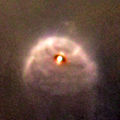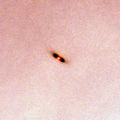在獵戶座大星雲 中的原行星盤。 電離原行星盤 (英語:proplyd )是指圍繞年輕恆星 外部因光致蒸發 的發光盤面 [ 註 1] 獵戶座大星雲 中發現了近180個電離原行星盤[ 1] 恆星形成區域 中的電離原行星盤非常少見,而獵戶座因為相對接近地球 ,是唯一一個擁有大量已知樣本的區域[ 2]
1979年,日中峰天文台 拉勒曼德電子相機 在獵戶四邊形星團 附近顯示了六個未能解析的高電離源。這些來源沒有被解釋為電離原行星盤,而是部分電離球(PIGs,partly ionized globules)。這個想法是,這些物體被M42 從外部電離[ 3] 甚大天線陣 的觀測顯示,這些來源凝聚的大小相當於太陽系的尺度。因而出現了這樣的想法:這些物體可能是被原恆星蒸發出來,環繞在低質量恆星周圍的吸積盤[ 4]
1993年,使用哈伯太空望遠鏡 的廣視場相機獲得的圖像,清楚地解決了Propllyds,並使用了術語"proplyd"[ 5]
在獵戶座大星雲中,觀察到的電離原行星盤通常是兩種類型之一。在發光 恆星周圍有一些輝光 ,發現是在圓盤靠近恆星的情況下,因恆星的光度而發光。其它被發現在離主星更遠地方的電離原行星盤,由於來自圓盤本身較冷的塵埃和氣體的自我遮蔽,它們顯示為黑暗的輪廓。一些電離原行星盤顯示出輻照度 太陽 約1,500光年 ,有非常活躍的恆星形成 。 獵戶座大星雲和太陽都位於銀河系 的同一螺旋臂 中[ 6] [ 7] [ 8] [ 9]
一個電離原行星盤可以形成新的行星 和微行星 系統。目前的模型表明,恆星和行星的金屬量 ,以及正確的行星系溫度和距恆星的距離,是行星和微行星形成 的關鍵。迄今為止,太陽系 有8顆行星,5顆矮行星 和5個微行星系統,是發現的最大行星系 [ 10] [ 11] [ 12] [ 13] [ 14] [ 15] [ 16] [ 17] [ 18]
如史匹哲太空望遠鏡 所見,塵土飛揚的電離原行星盤指向靈魂星雲 中的HD 17505 用哈伯太空望遠鏡 發現了其它恆星形成區的光致蒸發電離原行星盤。NGC 1977 目前代表獵戶座大星雲以外擁有最多電離原行星盤的恆星形成區,有7個已確認的電離原行星盤。這也是B型恆星獵戶座42 負責光致蒸發的第一個例子[ 19] NGC 2024 區域,發現了4個明確的和4個候選的電離原行星盤,其中兩個是被B型星光致蒸發[ 20] NGC 2024 的電離原行星盤意義重大,因為它們暗示了原行星盤的外部光致蒸發甚至可以與非常早期的行星形成(在前五十萬年內)競爭。
另一種類型的光致蒸發是用史匹哲太空望遠鏡 發現的。這些彗尾代表塵埃 被拉離原行星盤[ 21] 靈魂星雲 ,特別是在HD 17505 [ 22] 天文單位 的內部圓盤[ 23]
獵戶座大星雲和其它恆星形成區的電離原行星盤,代表了低質量恆星 周圍的原始行星盤,這些盤的外部被光致蒸發。這些低質量的電離原行星盤通常位於大質量OB恆星的0.3秒差距 (60,000天文單位 )內,塵埃狀的電離原行星盤具有長度為0.1至0.2秒差距(20,000至40,000天文單位)的尾巴[ 21] 類電離原行星盤天體 NGC 3603 和後來在天鵝座OB2 中的天體被建議為獵戶座大星雲中發現的明亮電離原行星盤的中間大質量版本。以天鵝座OB2中的類電離原行星盤天體為例,大多數與OB恆星 的距離為6至14秒差距,尾部長度為0.11至0.55秒差距(24,000至113,000 w天文單位)[ 24] [ 25] [ 26]
由
哈伯太空望遠鏡 拍攝的獵戶座大星雲內幾個電離原行星盤的影像
來自哈伯太空望遠鏡,在獵戶座大星雲中常明亮的181-825
來自哈伯太空望遠鏡,獵戶座大星雲中的黑暗電離原行星盤132-1832
來自哈伯太空望遠鏡,獵戶座大星雲中明亮的170-249。向上的尾巴是從激發的電離原行星盤中吹走的一股塵埃和氣體噴流。
由
哈伯太空望遠鏡 拍攝的恆星形成區
NGC 1977 的電離原行星盤影像
被
天鵝座OB2 星協的大質量恆星照亮的一個所謂類電離原行星盤天體,
^ Ricci, L.; et al. The Hubble Space Telescope/Advanced Camera for Surveys Atlas of Protoplanetary Disks in the Great Orion Nebula . Astronomical Journal. 2008, 136 (5): 2136–2151. Bibcode:2008AJ....136.2136R doi:10.1088/0004-6256/136/5/2136 ^ Sharkey, Colleen; Ricci, Luca. Born in beauty: proplyds in the Orion Nebula (新闻稿). Hubble/ESA, Garching, Germany. NASA/ESA. Dec 14, 2009 [Aug 4, 2015] . (原始内容 存档于2019-09-03). ^ Laques, P.; Vidal, J. L. Detection of a new kind of condensations in the center of the Orion Nebula, by means of S 20 photocathodes associated with a Lallemand electronic camera.. Astronomy & Astrophysics. March 1979, 73 : 97–106. Bibcode:1979A&A....73...97L ISSN 0004-6361 (英语) . ^ Churchwell, E.; Felli, M.; Wood, D. O. S.; Massi, M. Solar System--sized Condensations in the Orion Nebula. Astrophysical Journal. October 1987, 321 : 516. Bibcode:1987ApJ...321..516C ISSN 0004-637X doi:10.1086/165648 (英语) . ^ O'dell, C. R.; Wen, Zheng; Hu, Xihai. Discovery of New Objects in the Orion Nebula on HST Images: Shocks, Compact Sources, and Protoplanetary Disks. Astrophysical Journal. June 1993, 410 : 696. Bibcode:1993ApJ...410..696O ISSN 0004-637X doi:10.1086/172786 (英语) . ^ Space Telescope, Born in beauty: proplyds in the Orion Nebula, 14 December 2009 . [2021-12-30 ] . (原始内容 存档于2019-09-03). ^ Space Telescope, Proplyds . [2021-12-30 ] . (原始内容 存档于2017-05-10). ^ Nemiroff, R.; Bonnell, J. (编). Planetary Systems Now Forming in Orion . Astronomy Picture of the Day . NASA . 22 December 2009. ^ Nemiroff, R.; Bonnell, J. (编). Planetary Systems Now Forming in Orion . Astronomy Picture of the Day . NASA . 7 December 1996. ^ Windows 2 Universe, Solar System . [2021-12-30 ] . (原始内容 存档于2022-03-22). ^ universetoday.com, Solar System, by Matt Williams, 25 June 2016 . [2021-12-30 ] . (原始内容 存档于2022-03-09). ^ universetoday.com, Inner Planets of Our Solar System, by Matt Williams, 25 June 2016 . [2021-12-30 ] . (原始内容 存档于2014-07-03). ^ Caltech, Planet-Metallicity Correlation - The Rich Get Richer, by Ji Wang, Planet-Metallicity Correlation . [2021-12-30 ] . (原始内容 存档于2017-07-13). ^ The Planet-Metallicity Correlation. 2005, April 200, by Debra A. Fischer, Jeff Valenti . [2021-12-30 ] . (原始内容 存档于2017-10-25). ^ arxiv.org, Revealing A Universal Planet-Metallicity Correlation For Planets of Different Sizes Around Solar-Type Stars, by Ji Wang, Debra A. Fischer, 29 Oct 2013 . [2021-12-30 ] . (原始内容 存档于2017-10-02). ^ Astrobiology Magazine, astrobio.net, When Stellar Metallicity Sparks Planet Formation, By Ray Sanders, 9 April 2012 . [2021-12-30 ] . (原始内容 存档于2016-08-14). ^ From Lithium to Uranium (IAU S228): Elemental Tracers of Early Cosmic Evolution
By International Astronomical Union. Symposium, by Vanessa Hill, Patrick Francois, Francesca Primas, page 509-511, "the G star problem"
^ Oxford Journals Dynamics and accretion of planetesimals, by Eiichiro Kokubo1 and Shigeru, June 14, 2012 ^ Kim, Jinyoung Serena; Clarke, Cathie J.; Fang, Min; Facchini, Stefano. Proplyds Around a B1 Star: 42 Orionis in NGC 1977. The Astrophysical Journal. July 2016, 826 (1): L15. Bibcode:2016ApJ...826L..15K ISSN 2041-8205 S2CID 118562469 arXiv:1606.08271 doi:10.3847/2041-8205/826/1/L15 hdl:10150/621402 (英语) . ^ Haworth, Thomas; Jinyoung, Kim; Winter, Andrew; Hines, Dean; Clarke, Cathie; Sellek, Andrew; Ballabio, Giulia; Stapelfeldt, Karl. Proplyds in the flame nebula NGC 2024 (PDF) . Monthly Notices of the Royal Astronomical Society. March 2021, 501 (3): 3502–3514 [2021-12-30 ] . arXiv:2012.09166 doi:10.1093/mnras/staa3918 原始内容 (PDF) 存档于2021-08-15). ^ 21.0 21.1 Balog, Zoltan; Rieke, G. H.; Su, Kate Y. L.; Muzerolle, James; Young, Erick T. Spitzer MIPS 24 μm Detection of Photoevaporating Protoplanetary Disks. The Astrophysical Journal Letters. 2006-09-25, 650 (1): L83. Bibcode:2006ApJ...650L..83B ISSN 1538-4357 arXiv:astro-ph/0608630 doi:10.1086/508707 (英语) . ^ Koenig, X. P.; Allen, L. E.; Kenyon, S. J.; Su, K. Y. L.; Balog, Z. Dusty Cometary Globules in W5. The Astrophysical Journal Letters. 2008-10-03, 687 (1): L37. Bibcode:2008ApJ...687L..37K ISSN 1538-4357 arXiv:0809.1993 doi:10.1086/593058 (英语) . ^ Balog, Zoltan; Rieke, George H.; Muzerolle, James; Bally, John; Su, Kate Y. L.; Misselt, Karl; Gáspár, András. Photoevaporation of Protoplanetary Disks. The Astrophysical Journal. November 2008, 688 (1): 408. Bibcode:2008ApJ...688..408B ISSN 0004-637X arXiv:0807.3724 doi:10.1086/592063 (英语) . ^ Wright, Nicholas J.; Drake, Jeremy J.; Drew, Janet E.; Guarcello, Mario G.; Gutermuth, Robert A.; Hora, Joseph L.; Kraemer, Kathleen E. Photoevaporating Proplyd-Like Objects in Cygnus Ob2. The Astrophysical Journal. February 2012, 746 (2): L21. Bibcode:2012ApJ...746L..21W ISSN 2041-8205 S2CID 16509383 arXiv:1201.2404 doi:10.1088/2041-8205/746/2/L21 (英语) . ^ Brandner, Wolfgang; Grebel, Eva K.; Chu, You-Hua; Dottori, Horacio; Brandl, Bernhard; Richling, Sabine; Yorke, Harold W.; Points, Sean D.; Zinnecker, Hans. HST/WFPC2 and VLT/ISAAC Observations of Proplyds in the Giant H II Region NGC 3603* . The Astronomical Journal. January 2000, 119 (1): 292. Bibcode:2000AJ....119..292B ISSN 1538-3881 S2CID 15502401 arXiv:astro-ph/9910074 doi:10.1086/301192 (英语) . ^ Guarcello, M. G.; Drake, J. J.; Wright, N. J.; García-Alvarez, D.; Kraemer, K. E. Accretion and Outflow in the Proplyd-Like Objects Near Cygnus Ob2. The Astrophysical Journal. September 2014, 793 (1): 56. Bibcode:2014ApJ...793...56G ISSN 0004-637X arXiv:1409.1017 doi:10.1088/0004-637X/793/1/56 (英语) .







